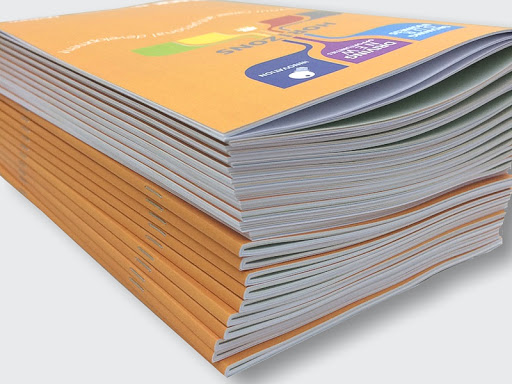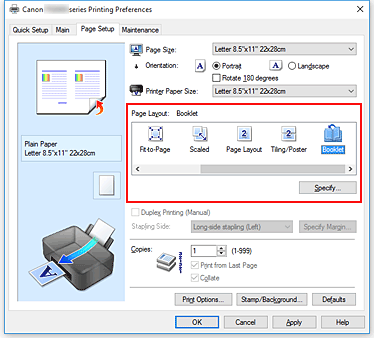How to Combine Print and Digital for Next-Level Booklet Printing
How to Combine Print and Digital for Next-Level Booklet Printing
Blog Article
The Vital Guide to Comprehending Booklet Printing Options and Techniques
The procedure of booklet printing includes several factors to consider that can substantially influence the end product. From picking the proper format and size to understanding the subtleties of binding techniques, each choice plays a vital duty. In addition, aspects such as paper stock and printing techniques more influence the efficiency of the booklet. As one browses these alternatives, it ends up being critical to realize how they adjoin and what that implies for the overall end result.
Understanding Booklet Styles and Sizes
When considering brochure printing, comprehending the numerous styles and dimensions available is crucial for achieving the desired discussion. Brochures can be created in countless layouts, including saddle-stitched, spiral-bound, and perfect-bound, each offering unique benefits. Typical sizes range from standard letter (8.5 x 11 inches) to smaller sized choices like A5 (5.8 x 8.3 inches), enabling versatility based upon material and target audience.Selecting the ideal dimension can influence both the format and reader interaction. Bigger sizes could fit aesthetically driven content, while smaller styles might be more user-friendly and portable. Furthermore, the variety of web pages affects the option of binding approach, as thicker pamphlets might need tougher bindings. Ultimately, recognizing these facets permits an extra customized approach, making sure that the end product lines up with the designated message and visual, boosting the total efficiency of the communication.
Choosing the Right Paper Stock

Binding Approaches: Considerations and options
When it concerns binding methods for brochures, numerous options are offered, each with unique advantages. Saddle stitch binding uses an affordable option for thinner pamphlets, while excellent binding methods give a more refined search for thicker magazines. Wire-O binding stands out for its resilience and simplicity of use, making it excellent for documents that require flexibility.
Saddle Stitch Binding
Saddle stitch binding uses a sensible and cost-efficient remedy for setting up brochures, making it a popular choice among authors and organizations. This binding approach entails folding sheets of paper in fifty percent and stapling them along the fold line, producing a cool and orderly appearance. Typically ideal for pamphlets with a reduced page count, saddle sewing is ideal for magazines, pamphlets, and instructional materials. The simpleness of this technique permits quick manufacturing and is often favored for advertising items or brief runs. Nevertheless, it is vital to note that saddle stitch binding might not appropriate for thicker pamphlets, as the spinal column might not stand up under raised weight. In general, it remains a dependable choice for numerous printing tasks.
Perfect Binding Methods
Perfect binding is a widely made use of strategy that supplies a sleek and expert coating to pamphlets and magazines. This method includes gluing the pages with each other at the spine using a strong adhesive, permitting a tidy side and the ability to hold a bigger number of web pages contrasted to saddle stitching. Perfect binding is especially suitable for thicker brochures, such as catalogs and annual records, where a strong, flat back is preferred. In addition, it offers the choice for a published cover that can be developed to enhance visual allure. However, considerations such as page count, paper weight, and the intended use of the booklet must be thought about, as they can influence longevity and general top quality.
Wire-O Binding Choices
Wire-O binding, understood for its longevity and flexibility, provides an outstanding alternative for pamphlets that need simple web page transforming and a specialist look. This binding method employs a collection of steel loopholes that hold web pages firmly, permitting them to lie flat when open. It is especially ideal for manuals, brochures, and discussions as a result of its durable nature. Wire-O binding is offered in different colors and sizes, suiting various web page counts and densities. In addition, it allows the inclusion of covers and tabs, enhancing the pamphlet's total visual. Considerations for Wire-O binding include the selection of cord shade, the dimension of the loopholes, and the degree of modification wanted, all of which can greatly affect the end product's look and capability.
Digital vs. Offset Printing: Which Is Best for You?
When choosing a printing method for pamphlets, recognizing the differences between electronic and balance out printing is vital. Digital printing utilizes modern-day technology to generate high-grade prints swiftly and affordably, making it excellent for short runs or tasks needing fast turn-around times. It allows for modification, supplying the capability to publish on-demand with very little waste.In comparison, balance out printing is a traditional approach that masters generating big quantities with constant quality. It involves moving ink from a plate to a rubber blanket, after that to the paper, which causes accurate information and vivid colors. Balance out printing typically needs longer arrangement times and is more economical for bigger volumes.Ultimately, the selection in between digital and balance out printing depends on job needs, budget, and desired amount. For small, time-sensitive projects, digital could be the very best selection, while offset may be more effective for bigger, top quality productions.

Designing Your Brochure: Tips and Best Practices
When designing a pamphlet, mindful interest to design, font style selection, and shade usage can considerably improve its efficiency. A hop over to here well-structured design guides the viewers's eye, while proper font styles guarantee readability and share the desired tone. In addition, reliable use color can evoke feelings and emphasize crucial information, making the general style extra impactful.
Picking the Right Layout
How can one properly select the best design for a pamphlet? It is necessary to evaluate the booklet's purpose and target audience. A clean, organized design improves readability and involvement. Making use of a grid system can help in straightening aspects continually, developing a professional appearance. In addition, including aesthetic power structure with differing sizes and positionings of images and text can guide the viewers's eye and highlight vital info. It is additionally important to leave sufficient white room, which prevents congestion and permits for better emphasis. Examining different formats through mock-ups can supply understanding into exactly how the style executes in real-world scenarios, guaranteeing that the last item fulfills both practical and aesthetic needs. Practical Picking Proper Typefaces
An appropriate typeface can substantially boost the total style of a booklet, complementing the format and reinforcing the content's message. The selection of fonts ought to consider readability, specifically for body text, as it assures the information is easily accessible to all readers. Sans-serif font styles are typically favored for digital layouts, while serif font styles can provide a typical feeling in published products. It's recommended to limit font choices to two or three to preserve aesthetic comprehensibility. In addition, font style size plays an essential role; headings need to be distinctive yet not overwhelming, while body text ought to be comfy for reading. When selecting fonts, placement with the booklet's motif and target audience is necessary for efficient communication and visual appeal.
Efficient Usage of Color
Color works as a powerful tool in booklet style, shaping perceptions and guiding viewers emotions. It can stimulate sensations of trust, enjoyment, or peace, depending on the hues selected. Designers ought to think about shade theory concepts, guaranteeing that the selected palette aligns with the pamphlet's message and target audience. For example, using warm shades like red and orange can develop seriousness, while cooler tones like eco-friendly and blue foster tranquility.Additionally, contrast plays an essential function; corresponding shades can enhance readability and aesthetic charm. Uniformity in color usage throughout pages additionally strengthens brand identification and cohesion. Eventually, reliable shade application not only records interest yet also enhances the pamphlet's objective, making it an important element of successful layout.
Ending Up Touches: Coatings and Unique Effects
While several take into consideration the content and format of a brochure the most vital aspects, the finishing touches, such as coatings and special results, play a crucial role in enhancing its overall charm. Coatings can offer defense and durability, making certain that the booklet holds up against damage. Matte finishes use an innovative, non-reflective surface area, while glossy coverings can make shades appear even more attractive and vivid. Unique effects, like embossing or aluminum foil stamping, add a responsive measurement that can create a remarkable perception. These techniques can highlight details areas, accentuating important details or producing aesthetic rate of interest. Additionally, UV finish can offer a high-shine surface that elevates the general look.Together, these finishing touches not just enhance the brochure's visual yet likewise connect expertise and interest to information, ultimately leaving a long-term influence on the reader.
Expense Factors To Consider for Booklet Printing
Recognizing the numerous price considerations for brochure printing is essential for organizations and services aiming to enhance their spending plans. Key elements affecting prices include the option of ink, binding, and paper approaches. Better materials, such as exceptional paper or specialized inks, typically enhance the total expenditure. Additionally, the size and page count of the brochure play a substantial role; larger brochures require even more sources and time to produce.Another essential factor to consider is the printing method, whether electronic or countered, as each has its very own prices framework and viability for various amounts. Businesses should also consider style expenses, which can vary based on complexity and making use of expert services. Ultimately, shipping and handling fees can contribute to the total, especially for large orders. By evaluating these elements, organizations can make informed decisions that straighten my website with their economic capacities while attaining the wanted top quality in their published products.
Often Asked Concerns
What Are the Environmental Impacts of Pamphlet Printing?
The ecological effects of booklet printing include logging from paper manufacturing, carbon emissions from transportation, and waste generation from thrown out products - Booklet Printing. Sustainable practices, such as making use of recycled paper and green inks, can reduce these results
Just How Can I Make Sure Color Precision in My Brochure?
To guarantee color accuracy in a pamphlet, one need to use calibrated displays, utilize specialist color accounts, perform test prints, and choose top notch printing solutions that offer color matching and proofing options for best outcomes.
What Is the Typical Turn-around Time for Pamphlet Printing?
The regular turnaround time for pamphlet printing differs relying on the complexity and amount - Booklet Printing. Typically, it ranges from a couple of days to two weeks, affected by elements such as publishing methods and ending up requirements
Exist Minimum Order Quantities for Brochure Printing?

Can I Print Booklets in Several Languages?
Publishing pamphlets in multiple languages is possible. Numerous printing services use alternatives for multilingual or bilingual designs, enabling reliable interaction. Mindful planning guarantees that make elements fit numerous languages without endangering readability or appearances. In addition, variables such as paper stock and printing methods more influence the performance of the booklet. When thinking about pamphlet printing, understanding the different styles and sizes available is essential for attaining the desired presentation. When selecting a printing method for brochures, comprehending the like this differences in between digital and balance out printing is important. In addition, the size and page count of the brochure play a significant duty; bigger pamphlets call for more sources and time to produce.Another vital factor to consider is the printing method, whether digital or balanced out, as each has its own prices framework and suitability for different amounts. The environmental influences of brochure printing include logging from paper production, carbon discharges from transportation, and waste generation from thrown out materials.
Report this page